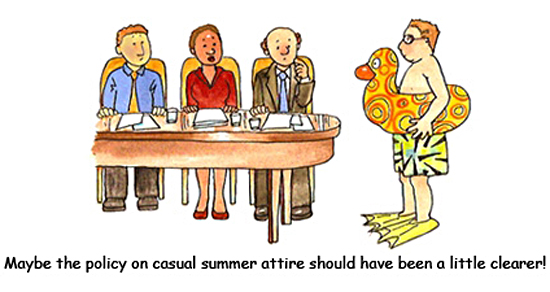You’re Going to Wear That…to Work!?
Many companies allow their employees to dress more “casually” during the summer months. It is fully understandable if employees want to wear more comfortable clothes when it’s hot and humid outside, but where do you draw the line?
Wearing less clothing will help employees stay cool but it may give a bad impression if you are not careful. For the sake of your business, I’d discourage you from allowing certain summer attire in the office, such as:
Flip Flops: Feet that are exposed or not clean are not fun to look at. Period. What happens if someone spills their morning coffee on them? Ouch! Plus, that annoying sound of a flip flop hitting someone’s heel is not only annoying – but unprofessional!
Shorts: Shorts are for sports and we need clear boundaries between work and relaxation. Plus, do you really want to see guys comparing calf muscles? I didn’t think so.
T-Shirts: V-necks that go down to our belly buttons are not considered T-Shirts. It might be an awkward situation to tell your employee that he is not Tom Selleck and no one needs to see that much chest hair.
Short Skirts: What happens when a sudden wind blows in and you have a Marilyn Monroe moment in the office? Quite simply – if your mother would have given you a hard time about leaving home wearing it – it’s likely not for the work environment either.
Beachwear: We would all love to have volleyball tournaments at work, but the sand is at the beach, not in your office. Bikini tops and bathing suits should stay at the beach as well.
What should you include in your policy?
So now that I have convinced you to dress appropriately for work, here are some tips to creating a summer dress code:
- Put a dress code in place months before summer arrives: This guarantees that everyone is notified of the rules and they have plenty of time to ask questions if they are unsure about the company’s policy.
- Be specific: Spell out exactly what type of clothing is restricted and why, this way the employee fully understands the issues of the restricted garments. The dress code should specify all consequences for transgressions.
- Treat all employees equally: Do not handle cases differently based on age, gender, attractiveness or seniority. Yes, some people do look good in spandex but this is a select few. It is not sexual harassment to tell an employee that they cannot wear a certain article of clothing to work. As soon as one employee gets away with wearing something inappropriate, others will surely follow.
What should you do if someone violates your company’s policy?
Speak to that employee in private. There could be a disability or religious reason for the violation. If not, see if the violation can be corrected without sending the employee home.
If you need help creating a proper dress code policy, or have any further questions, we can help. Call our office; speak to a human resource professional about your company’s policies or employee handbook at 631-794-7400 or write to us at: [email protected]
This is not legal advice and will not cover all situations and circumstances.







